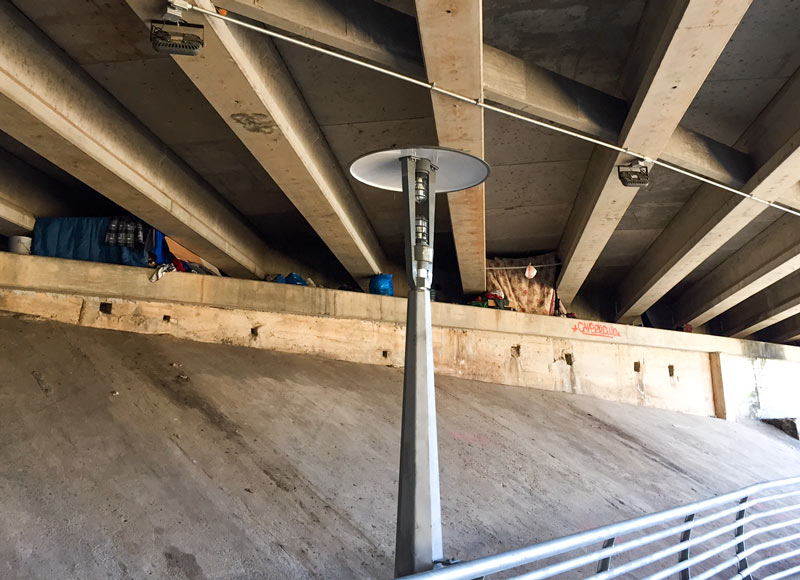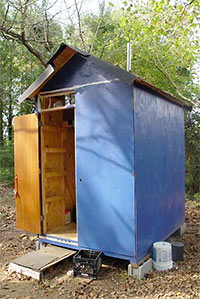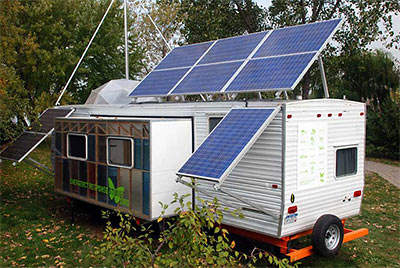LAWSUIT ALREADY FILED OVER THE TENT BAN THAT TOOK EFFECT FRIDAY  This morning the Texas ACLU filed for an injunction on the City’s new ordinances aimed at Houston’s homeless folks and panhandlers, Meagan Flynn reports this afternoon for the Houston Press. The new rules (which among other things ban sleeping in tents or boxes, make it illegal to possess a grill or more than a 3-by-3-by-3-foot box’s worth of stuff in public, and prohibit panhandling close to people, ATMs and payphones) went into effect on Friday. An ACLU staff attorney said in a statement that the rules step away from Houston’s previously “humane approach” to reducing homelessness, adding that “they’re meant to get people into shelters with ‘tough love,’ but the truth is the shelters are full and Houston’s homeless have nowhere else to go.†Flynn points out that the Coalition for the Homeless’s homeless count last year estimated that only 164 shelter beds were vacant on a night when 1,046 people were sleeping on the streets. [Houston Press; previously on Swamplot] Photo of previously cleared homeless encampment under Louisiana St. Bridge downtown: Christine Wilson
This morning the Texas ACLU filed for an injunction on the City’s new ordinances aimed at Houston’s homeless folks and panhandlers, Meagan Flynn reports this afternoon for the Houston Press. The new rules (which among other things ban sleeping in tents or boxes, make it illegal to possess a grill or more than a 3-by-3-by-3-foot box’s worth of stuff in public, and prohibit panhandling close to people, ATMs and payphones) went into effect on Friday. An ACLU staff attorney said in a statement that the rules step away from Houston’s previously “humane approach” to reducing homelessness, adding that “they’re meant to get people into shelters with ‘tough love,’ but the truth is the shelters are full and Houston’s homeless have nowhere else to go.†Flynn points out that the Coalition for the Homeless’s homeless count last year estimated that only 164 shelter beds were vacant on a night when 1,046 people were sleeping on the streets. [Houston Press; previously on Swamplot] Photo of previously cleared homeless encampment under Louisiana St. Bridge downtown: Christine Wilson
Tag: Temporary Housing
THE NEXT BIG HURRICANE REBUILD WILL GO MUCH FASTER IF YOU START ON IT NOW Meanwhile, in Brownsville: Housing advocates in Dolly-battered South Texas have since developed a disaster response program optimistically called Rapido; new legislation (similar to a bill that failed in the last Texas legislative session) is in the works to make Rapido-style “precovery” response a statewide standard. The program involves the fast deployment of permanent 1-room housing “cores” that can be quickly assembled by local workers and then added onto later; the bigger component of the program, Leah Binkovitz writes this week, is extensive pre-planning initiatives in potential disaster areas, instead of what housing advocate John Henneberger calls “reinventing disaster recovery from a blank sheet of paper every time there’s a disaster.†Binkovitz writes that the program calls for preemptive outreach “to determine what kind of disaster housing would be most appropriate, who could build it, who would be eligible to receive it and what resources would be available. That conversation should even include whether folks want to rebuild in vulnerable neighborhoods and how to offer alternatives.” [Urban Edge; previously on Swamplot]
ATLANTA HUTS FOR HOUSTON’S HOMELESS  At yesterday’s meeting new city council member Jack Christie distributed descriptions of prefab huts and “low riders” produced by an Atlanta organization called Mad Housers, suggesting that similar structures — privately funded — could be used in Houston as they are in Atlanta: as shelters for homeless people. “You don’t see the sleeping bags out there, the newspapers,†Christie told reporter Chris Moran afterward. “These have a lock on the door so you have a sense of security.†The huts, which the Atlanta organization stresses are not intended as permanent housing, measure 6 ft. by 8 ft. with 12-ft. ceilings, and feature a sleeping loft, a locking door, and a wood-burning stove for heat and cooking. The “low riders” are 4 ft. by 8 ft. with only 4-ft. ceilings; they’re meant to allow residents to keep their shelters on the down-low, below vegetation lines or other screening objects where they wouldn’t want them to be too conspicuous. These smaller units come with a separate 4x4x4 storage box. [Houston Politics; Mad Housers] Photo: Mad Housers
At yesterday’s meeting new city council member Jack Christie distributed descriptions of prefab huts and “low riders” produced by an Atlanta organization called Mad Housers, suggesting that similar structures — privately funded — could be used in Houston as they are in Atlanta: as shelters for homeless people. “You don’t see the sleeping bags out there, the newspapers,†Christie told reporter Chris Moran afterward. “These have a lock on the door so you have a sense of security.†The huts, which the Atlanta organization stresses are not intended as permanent housing, measure 6 ft. by 8 ft. with 12-ft. ceilings, and feature a sleeping loft, a locking door, and a wood-burning stove for heat and cooking. The “low riders” are 4 ft. by 8 ft. with only 4-ft. ceilings; they’re meant to allow residents to keep their shelters on the down-low, below vegetation lines or other screening objects where they wouldn’t want them to be too conspicuous. These smaller units come with a separate 4x4x4 storage box. [Houston Politics; Mad Housers] Photo: Mad Housers
WHERE’S A STINKIN’ FEMA TRAILER WHEN YOU NEED ONE? Trailer sculptor Paul Villinski, on the difficulty of procuring the raw material for his Emergency Response Studio, now on display at the Rice Art Gallery: “I thought, OK I’m going to go get a FEMA trailer, because they’re selling them online through the government – you know, the GAO Web site – at that very moment, it seemed, FEMA basically stopped releasing the trailers into the marketplace. And not only did they do that, they bought back all the ones that they had already sold. . . . And the back story with that is basically that the plaintiffs in this class-action suit need a couple of FEMA trailers so they can really study the indoor air quality and FEMA and the manufacturers do not want them to have them. So they’ve been ordered by the judge in the case to release the trailers, and they haven’t done it yet. So that made it impossible for me to actually get a FEMA trailer, which is why I wound up finding a 30-foot Gulfstream Cavalier, but it was built a couple of years before the FEMA trailers were.” [Arts in Houston; previously in Swamplot]

A few months after Ike, this tricked-out FEMA trailer rolls into Houston as . . . art?? Paul Villinski’s reworked 30-ft. Gulfstream “Cavalier” trailer, which took the artist 7 months to mod, will be parked outside the Rice University Art Gallery starting later this month.
Re-born as the Emergency Response Studio, the trailer’s formaldehyde-ridden original materials are replaced by entirely “green†technology and building materials, including recycled denim insulation, bamboo cabinetry, compact fluorescent lighting, reclaimed wood, and natural linoleum floor tiles made from linseed oil. It is powered by eight mammoth batteries that store energy generated by an array of solar panels and a “micro†wind turbine atop a 40-foot high mast. Not only practical, Emergency Response Studio is a visually engaging structure with an expansive work area featuring a wall section that lowers to become a deck. A ten-foot, elliptical geodesic skylight allows extra headroom and natural lighting in the work area. Though designed as an artist’s studio and residence, Emergency Response Studio is an ingenious prototype for self-sufficient, solar-powered mobile housing.
Party on the back deck!
WHERE TO PUT MAGNOLIA GLEN If the city will cough up $4 million, developers will turn a former temporary UH dorm next to Fingers furniture on the north side of the Gulf Freeway into a 220-unit housing project for Houstonians who are currently homeless. Mayor White supports the Magnolia Glen project, but district councilman James Rodriguez and some residents of nearby Eastwood don’t like the location. “Former Councilman Gordon Quan, a member of the blue-ribbon commission, said . . . money helps determine where sites can be found. ‘People say, “Why don’t you put this in River Oaks or Memorial?” We couldn’t afford the land in River Oaks. But we are cognizant that these need to be spread around,’ he said.” [Houston Chronicle]
JUST ANOTHER HOUSTON HOMEBUILDER “But there are plenty of challenges to overcome first. To camp on the moon, astronauts need to be shielded from solar radiation. In a waterless environment every drop of H2O, including sweat and urine, must be recycled and purified. NASA engineers are sorting through dozens of possible models for the lunar outpost—from horizontal, aluminum cylinders to inflatable structures that are essentially giant, Kevlar-reinforced balloons.” [Smithsonian]
NEW SHORT-TERM HOUSING FOR 40 VETERANS, SOUTH OF THE MED CENTER There are an estimated 3,600 homeless veterans in the Houston area, and only 250 available beds. “Eight veterans already have moved into their new quarters in the previously vacant apartment complex in the 7300 block of Fannin. Applications to fill up the 14 units still are being accepted.” [Houston Chronicle]

